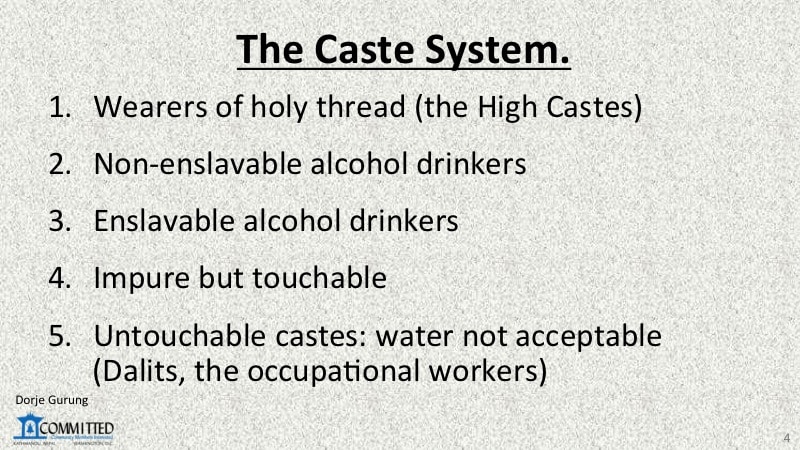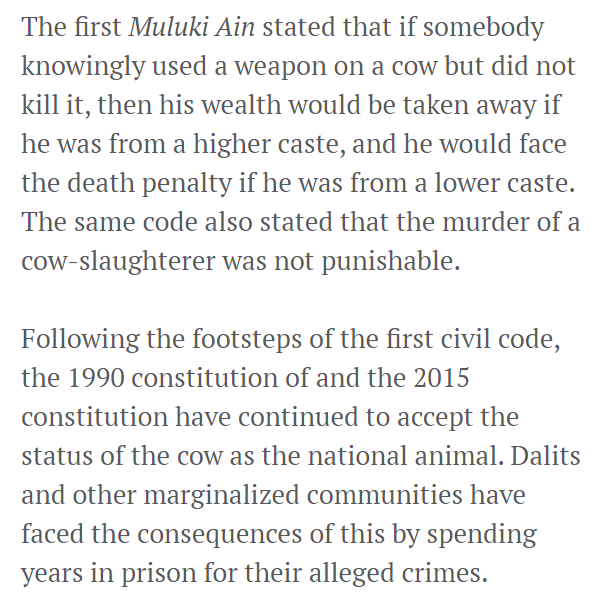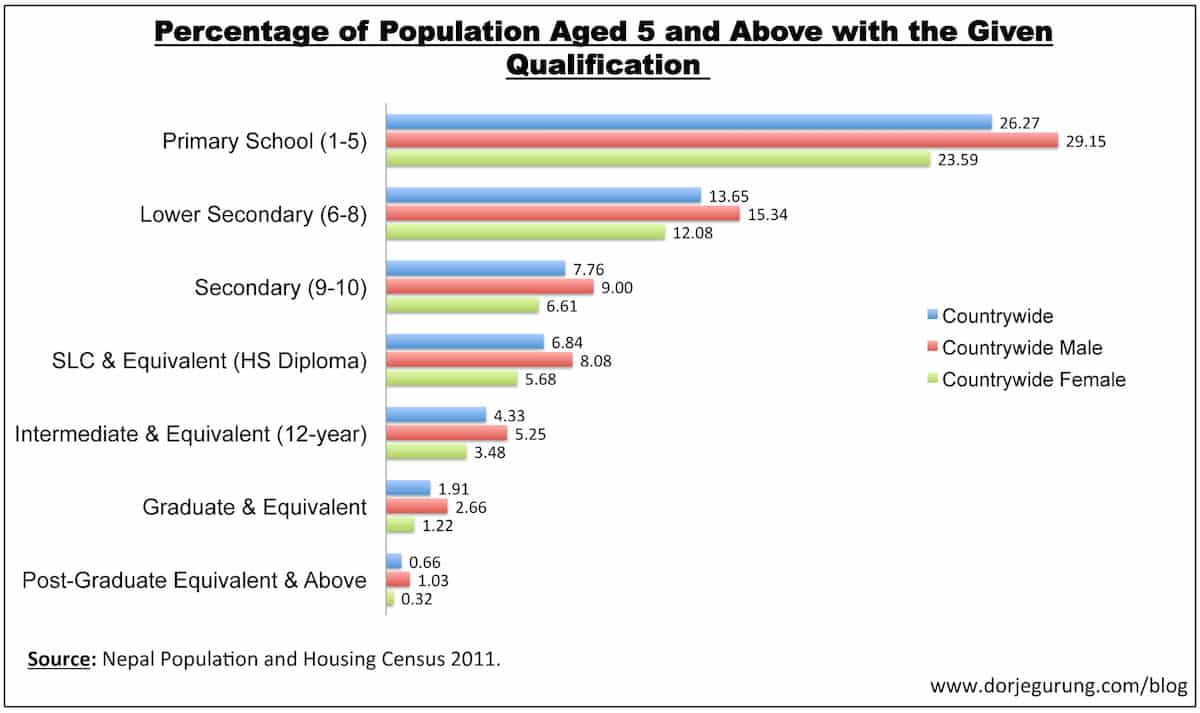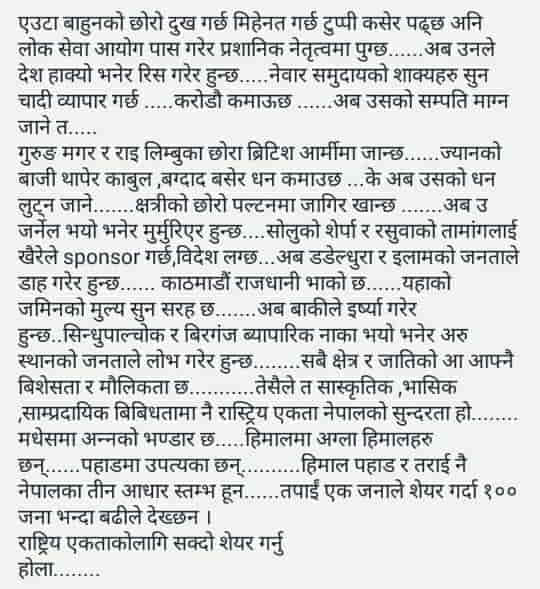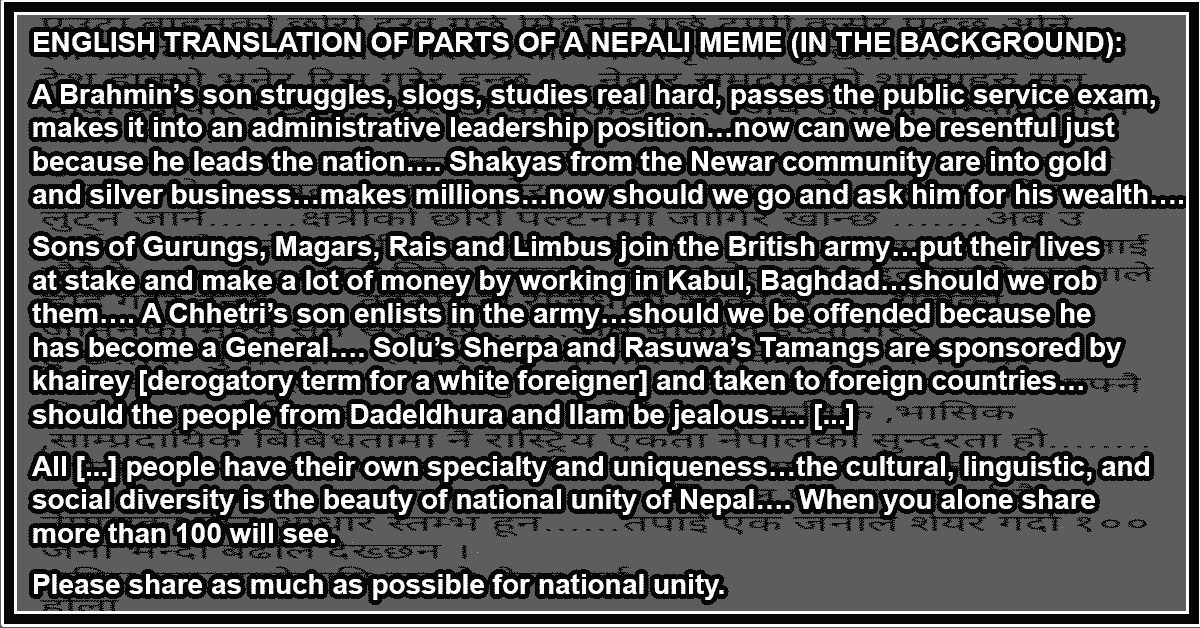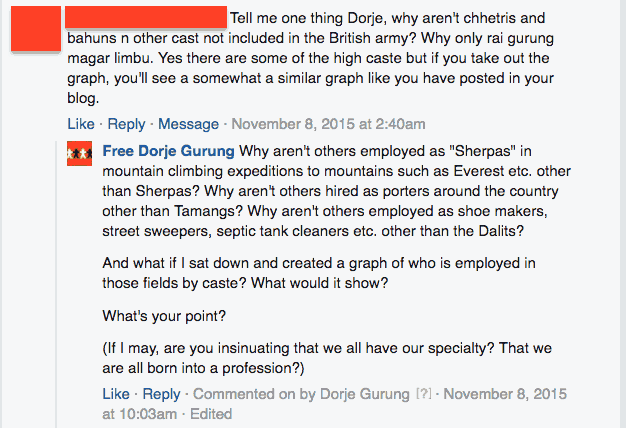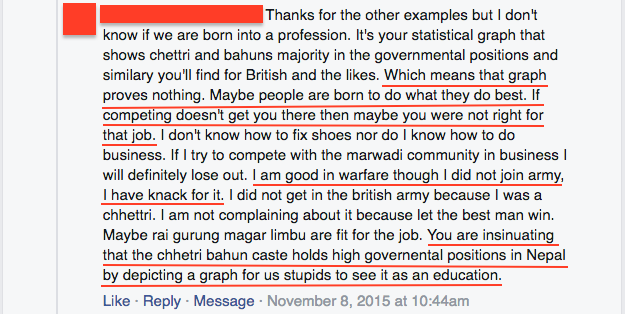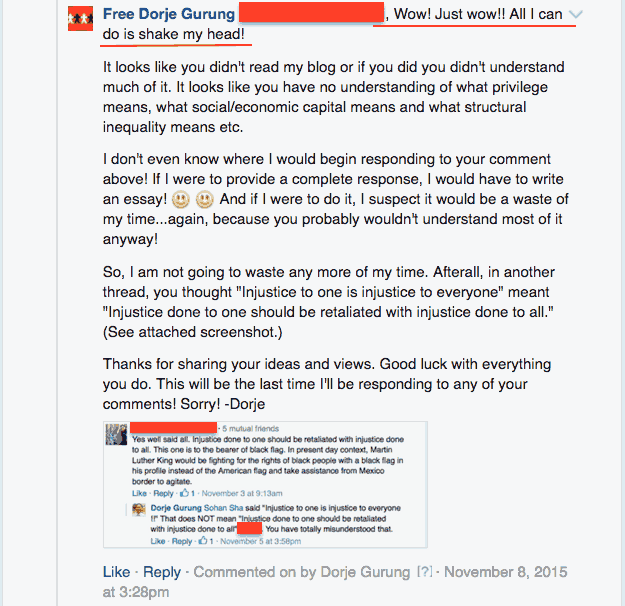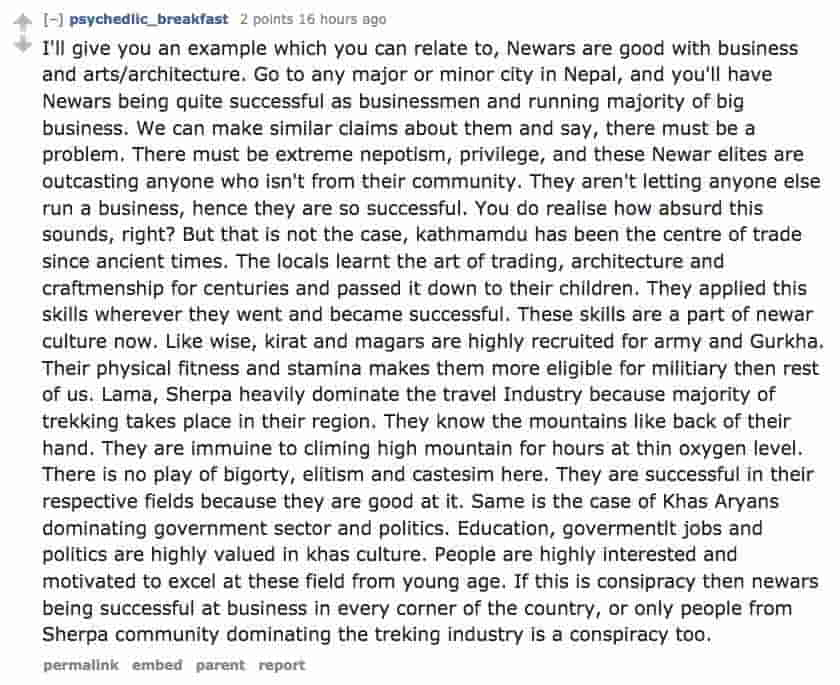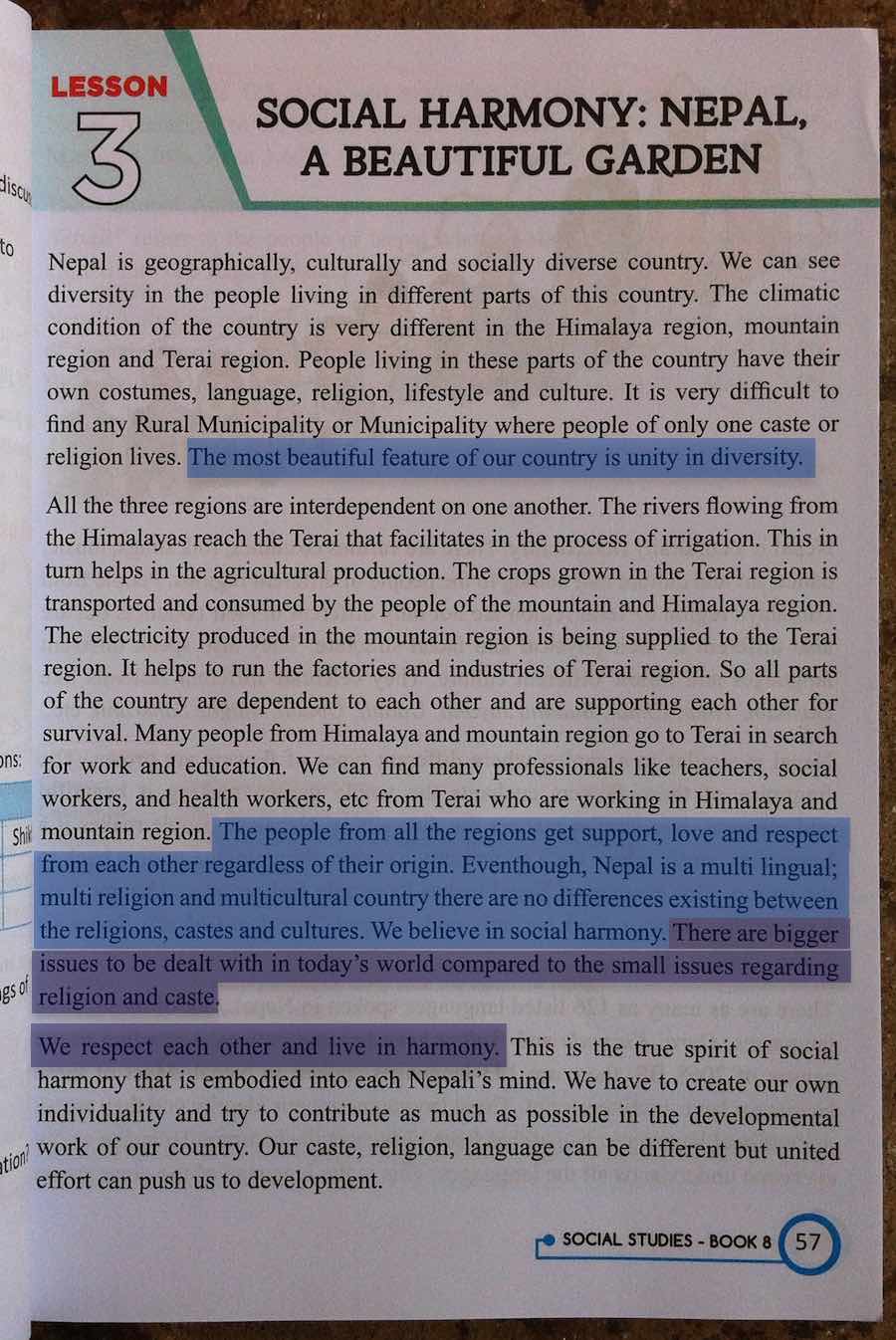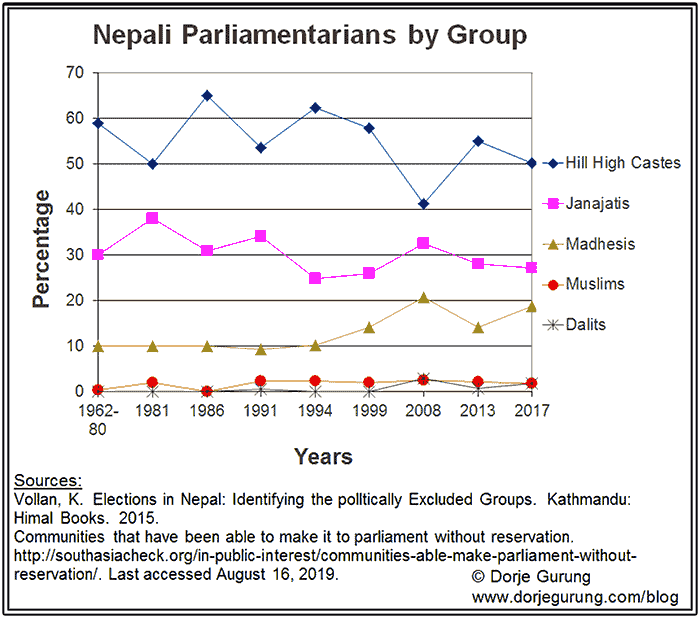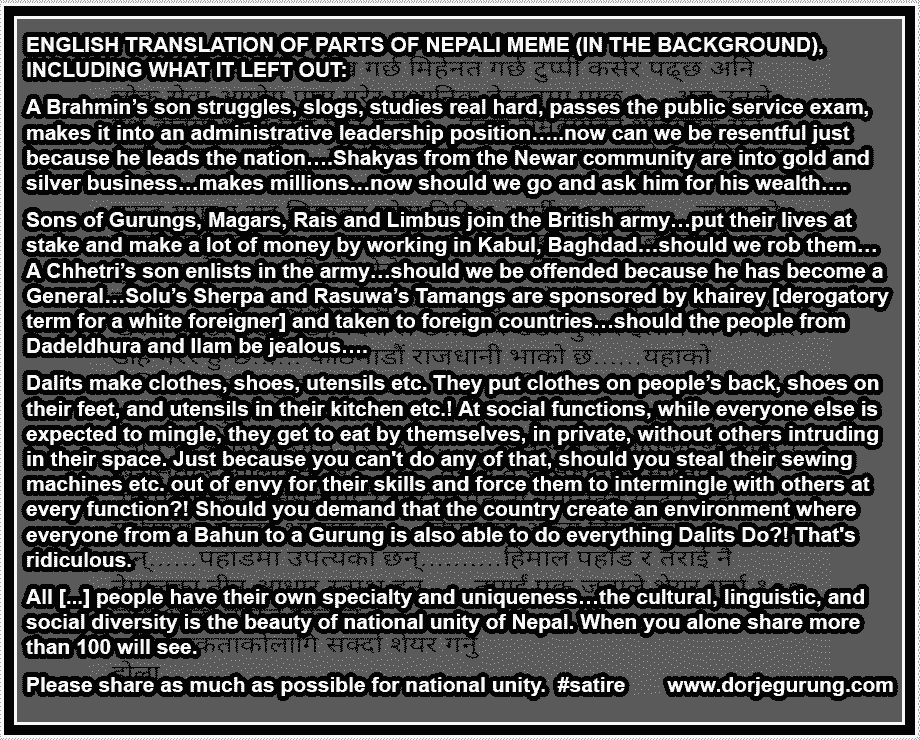If I had to identify one system in Nepal that has been the most devastating to Nepali society, it would be our social system: the Caste System. It divides the people of the country into five groups (see image below). It was enshrined in the Muliki Ain (Law of the Land, i.e. the constitution) of 1854 by the hill so-called high caste Hindus, the Brahmins/Bahuns and the Chhetris, also referred to as the Khas-aryas.
The caste system sanctioned the discrimination of the non-Khas-aryas by them as well as by the State at all kinds of levels and in all kinds of spheres. As you can see from the classification of the different peoples, to begin with, the law sanctioned enslavement of people belonging to certain castes (by the hill so-called high caste Hindus, of course).
The laws of the State, for example, allowed for differential punishments for a crime based on the caste of the perpetrator. In 1940, during the rule of the Rana oligarchy, for instance, Tanka Prasad Acharya, a Brahmin, was imprisoned while his four friends belonging to other castes were all hanged and shot to death for protesting against the oligarchs’ rule!
Here’s a quote from the article Criminalization of Cow-slaughter is a Tool of Caste Terror about one such law and how it unfairly criminalizes present-day Dalits and other marginalized groups.
The systems they set up ensured — and supported — structures that worked for them, systems that afforded them structural privileges. Pretty much all systems were of, by, and for them. In other words, they set up the country to essentially be their “playing field” but one that was steep, like the side of a mountain.
In this steep playing field all Nepalis played by the Khas-aryas’ rules. The Khas-aryas were “born” near the top, nearer the finish line as it were, while the rest started their “race” from farther down the side of the mountain, at different points.
The constitution was amended for the first time in 1963. But only the 1990 constitution drafted AFTER the autocratic Shah dynasty was toppled “outlawed caste-based discrimination in public spaces.” Naturally, progress countering the deeply embedded detrimental impact and influence of the system has been slow and incremental. I believe one of the main reasons behind that is the poor quality and level of education of the population (see image below), which of course is NOT accidental either. Yet another reason, as Bhimrao Ramji Ambedkar has argued and I agree with, is the vested interest of the Khas-aryas in the system.
So, it’s not surprising, again, that there are Nepalis who struggle to critically assess data, information, and their sources, and also struggle to provide logically sound arguments to support an idea or opinion etc.
When I came across an argument for celebrating our “diversity” and “national unity” for the first time back in 2015 in a meme (see image below), for example, I was intrigued.
Here’s a translation of just the relevant bits about life opportunities and “professions” of Nepalis. The meme touts them as symbols of diversity in the country and something to extol.
Another intriguing aspect of the meme is that the Nepal the maker lives in appears to be populated only by men (sons)! Based on that, I am assuming the maker to be a man (or men) blinded by patriarchy.
Additionally, the reason for the meme talking about jealousy is the Nepalis’ peculiar tendency to ‘pull down’ those perceived of as being more successful or more famous than themselves, referred to as the “Khutta tanne prabirti.”
While well-meaning, the argument the meme makes is flawed. It (unwittingly?) attempts to rally the people of the country around an argument that supports the maintenance of the caste system and, therefore, the widely prevalent structural inequality in the country. Not surprisingly, over time I would come across the same argument again and again.
In the following image, taken from Facebook exchanges I had with a number of people the Summer of 2015, the user I renamed FB C3 makes a similar argument.
FB C3 is also supported by S, another user!
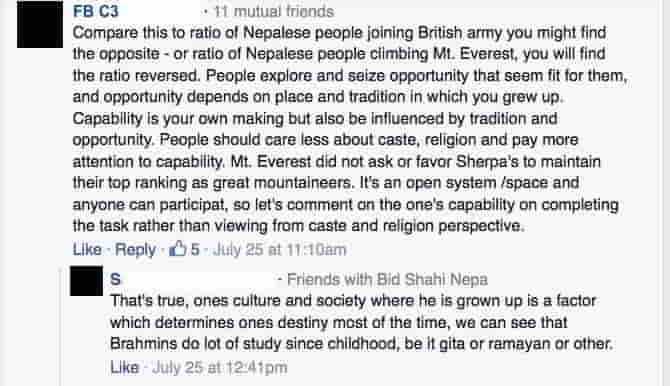
Then, towards the end of 2016, I had a fellow Nepali, under a Facebook status update that included a link to my blog post A Graph is Worth a Thousand Words…It Seems, gives a similar argument. This guy’s comment actually takes the cake!
He started by asking why different groups are found to be engaging in different “professions.” Realizing what exactly he was getting at, I lay a trap in which he fell really easily! If you read his response, you’ll notice he clearly had NO idea what I had done!
Notice how he says, “I am good in warfare though I did not join army [sic]. I have a knack for it. [Emphasis mine.]” That belief, sadly, is based ENTIRELY on his birth as a Chhetri, the warrior caste, and consistent with the doctrines of the caste system! By that point, he seems to have completely forgotten that he himself conceded in an earlier comment that “only rai gurung magar limbu [sic]” are recruited in the British Army. Why? Well, one of the reasons behind that must definitely be their martial skills!
What is true is that, like many other skills, martial skills is NOT something people are born with; it can be acquired. I know of no scientific studies that have discovered a gene or genes showing a “knack” or predisposition or propensity for a certain skill (such as martial skills, mountaineering, tailoring etc.) or a gene predisposing a person for a profession. But, he is so completely blinded and convinced of the caste system-induced belief in birth dictating “knack” that he seemed completely oblivious to the fact that he had contradicted himself.
Then, in the Fall of 2017, someone on Reddit made the same argument (see image below) under a share of the same blog post of mine by someone else!
AFTER COMING ACROSS them a few times, I started wondering about their source. It would take until the Summer of 2018 before I came across something that looked like it: a grade 8 Social Studies textbook. A sentence on page 57 of the book reads, “The most beautiful feature of our country is unity in diversity.” (See the first highlighted bit in the image below.) Depressingly, the textbook declares the caste system and religion as “small issues” (see the first purple highlighted bit).) Farther down (the last highlighted sentence) says we “live in harmony!”
I wasn’t convinced that the textbook was THE source though. Most Nepali school textbooks I have looked at have been severely lacking in originality, among other things. So, I kept my eyes open. And guess where I tracked it to? Our constitutions, specifically the 1990 and 2015 ones!
Apart from outlawing discrimination in public places, the 1990 Constitution recognized for the FIRST TIME the incredible diversity in the country. Until then, having established the country as basically their own “playing field,” the Khas-aryas had made every effort to actively suppress the highly multi-cultural, multi-lingual, and multi-ethnic characteristics of Nepali society and to actively also oppress most of those they had classified as so-called lower castes.
One of the many many things the ruling class did to that end, for a long time, was to either not collect data which would reflect the diversity OR, if they did, not publish them at all (see image below).
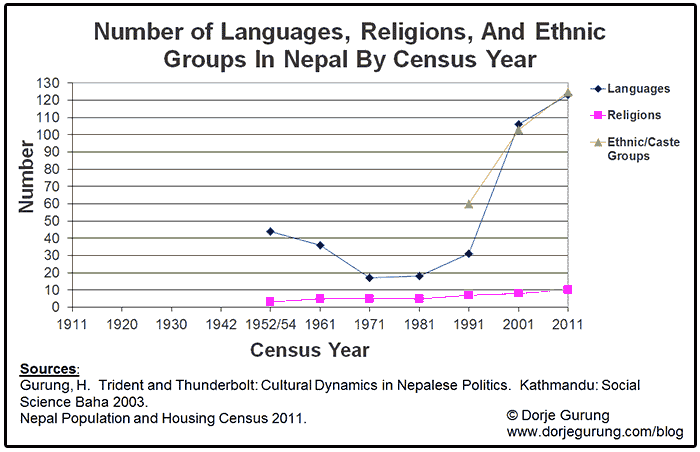
Notice the absence of data on Religions and Languages between 1911 and 1952. Notice also the absence of data for Ethnic/caste Groups until 1991, the first census report after the autocratic Shah regime was toppled, not surprisingly. Note also the pattern in the change of data over time, which of course isn’t accidental either!
As late as 1988, only the year before the People’s Revolution (Jana Andolan I), the one that overthrew the autocratic regime, Gopal Gurung was thrown in Jail for his publication Hidden Facts in Nepalese Politics.
Such suppression, for example, led to my own community of ethnic Tibetans from Mustang doing a lot of different things so as to appear to be “more Nepali” while being Nepali, such as celebrating Dassain and Tihar, the biggest Hindu festivals!
Designing and implementing development programs to uplift the marginalized were probably the furthest from the minds of the rulers then. According to Om Gurung (no relation to me, but if you know me well, you know that I am NOT even a Gurung), only the 9th iteration of the five-year plans drafted in 1997, seven years after the democratic form of government was instituted, finally, included programs intended to uplift the marginalized. But, as Gurung asserts, nothing really came of it because those implementing the program were not serious about their plans at all. After all, even in the democratically elected legislature, the Khas-aryas were disproportionately highly represented then and have been since, no different from how it had been in the past (see image below).
Returning to the 1990 constitution…the word “unity” appears in the preamble:
Under Article 26 State Policies, you will find both the word “diversity” and the phrase “national unity”:
This “national unity” or — as it appears elsewhere — this “harmonious relations” is described in the constitution, under Article 12 Right to Freedom, as just merely “subsisting” however! 😀 😀
There are four instances of “harmonious relations subsisting” under Article 12. No wonder, the patriots and (ultra)nationalists must keep reinforcing and reminding everyone about this “harmonious relations,” this “national unity,” this “unity in diversity”! 😉 😉
The catchy phrase “unity in diversity” of the peoples and places actually only appears in the 2015 constitution though! In the preamble of that constitution, that amazing feature ( 😉 😉 ) of Nepali society is described thus:
The 2015 constitution does away with the phrase “harmonious relations subsisting”! In it’s place, you find just “harmonious relations,” which appears 10 times in Part 3 Fundamental Rights and Duties! If it’s not clear already, the assumption appears to be that “harmonious relations” is a de facto characteristic of Nepali peoples of different castes, religions etc.
IN 1989 WE HAD a major revolution (Jana Andolan I) that toppled the autocratic regime. In 1996 we initiated a ten-year civil war. In 2006 we had the second People’s Revolution (Jana Andolan II) to topple the “second coming” of the autocratic Shah rule. In 2007 we had a major, violent regional uprising — in the Southern Plains — against the interim constitution. In 2015, almost a repeat of that violent uprising took place not long after the flawed but fast-tracked constitution was promulgated.
The aspirations of many who participated in all of those uprisings and resistances had been, to begin with, a more inclusive structures in the country in view of the incredibly diverse population. I am sure the 1990 constitution recognizing the truly diverse characteristic of Nepali society was to partly appease such aspirants.
Another aspiration, I am sure, must have been for the Nepali society and the State of Nepal to recognize AND acknowledge the wrongs that had been committed against many of its own people. Another expectation must have been for amends. Amends that included a constitution with provisions that would put the country on a path to righting those wrongs. Amends that would foster and encourage the creation of social, economic, and political environments in which the disenfranchised and marginalized majority, the lower castes, are able, firstly, to reclaim and reassert their culture, heritage, and identity; secondly, to claim their rightful seat at the table, as it were; and, thirdly and most importantly, to have their voices heard.
To that end, I am pretty sure support was also extended for federalism and, therefore, self-governance and self-determination through decentralization!
And yet, those in positions of power, the Khas-aryas, appear to only be interested in giving lip service to all that — such as by agreeing to pen a more progressive constitution — while actively undermining many of the gains.
Throughout most of the modern history of the country, a vast majority of the population except the hill so-called high caste Hindus have had to pretend to be (Hindu) “Nepali” while being Nepali. That changed in 1990 with the ushering of the new constitution and a democratic form of government. The non-high castes have been able to assert anew — and take pride in — their cultural, linguistic, and ethnic identities and heritages. For one evidence of that, check the patterns in changes to the languages, religions, and ethnic groups in the chart above.
And yet, returning to the constitution-inspired flawed argument, the all pervading and far reaching monstrosity of the caste system, buoyed by the poor quality and level of education of the population, and the single-minded drive of the powerful hill so-called high caste Hindus to retain their hold on power, has created citizens who sing praises about it, albeit indirectly, and call on people to recognize it as a unique AND uniting feature of our society worth maintaining and preserving!
Recognizing the ridiculousness of the argument, I published a whole satirical blog post All for National Unity… Well Maybe Not… All! centered around it. To round off the satire, I “completed” the meme by adding the “missing” bit to expose the fallacy in the argument (see image below). 😀 😀
How many will understand that even though all I did was to add just the logical extension to their argument? Do YOU understand it?
For many in Nepal to stop furthering — or NOT be duped by — such (and other) flawed arguments, the quality and level of education of the population must be raised DRAMATICALLY.
What do you think?

